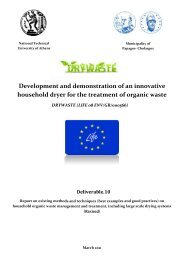MOROCOMP (LIFE TCY05/MA000141) - Unit of Environmental ...
MOROCOMP (LIFE TCY05/MA000141) - Unit of Environmental ...
MOROCOMP (LIFE TCY05/MA000141) - Unit of Environmental ...
You also want an ePaper? Increase the reach of your titles
YUMPU automatically turns print PDFs into web optimized ePapers that Google loves.
Doukkala region 3 , sugar beet leaves and straw residues were considered appropriate<br />
to be used as an input composting material due to their high availability and negligible<br />
cost. Furthermore manure <strong>of</strong> different origin was also used as raw material for<br />
compost. Sheep and cow manures were the types <strong>of</strong> manure used in the composting<br />
trials due to their high availability, low heavy metal content and the absence <strong>of</strong> other<br />
hazardous substances. Furthermore manures high nitrogen and phosphorous content<br />
constitutes a basic nutrient component for plant growth.<br />
4.1. Methods for sampling and analysis <strong>of</strong> the raw material<br />
The characterisation <strong>of</strong> the raw material that was used as a feedstock to the in-vessel<br />
composting bioreactor is essential for the evaluation <strong>of</strong> the aerobic composting<br />
processes and thus to the evaluation <strong>of</strong> the end products. The feedstock determines a<br />
priori the physical chemical and biological conditions involved in composting<br />
processes. The rate at which materials compost and the qualities <strong>of</strong> the final<br />
composted organic material are largely dependent on the initial selection and mixing<br />
<strong>of</strong> raw materials.<br />
For each examined raw material, six representative samples were being collected. The<br />
final sample was formed after stirring and mixing the six same weighted samples<br />
together to form a homogeneous material. From this homogeneous material six<br />
separate samples were selected from which a series <strong>of</strong> parameters were evaluated. The<br />
average value <strong>of</strong> each parameter was calculated from the average value <strong>of</strong> the separate<br />
samples. The examined parameters <strong>of</strong> the raw material are listed in Table 1. Table 1<br />
also presents the standard methods followed for testing and evaluating compost and<br />
composting feedstock material. These standard methods have been employed in order<br />
to analyse and evaluate the initial material that was selected to be composted as well<br />
as the end product that resulted after the composting process has been completed.<br />
3 greater area <strong>of</strong> El Jadida<br />
20










